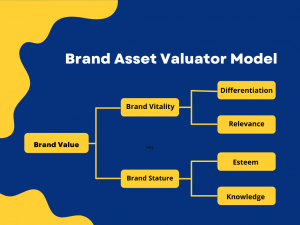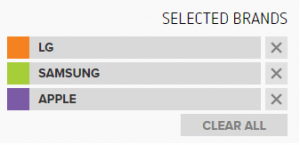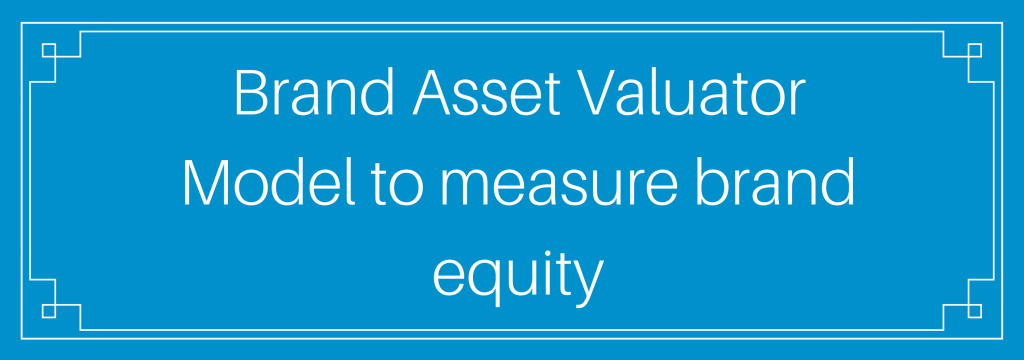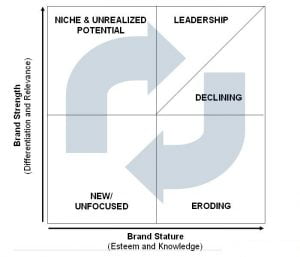The brand asset valuator model(BAV) can arguably call the most extensive brand research program ever done. To date, over 100,000 consumers across 32 countries have been interviewed. Information on more than 13,000 brands has been collected, providing up to 56 different scales and dimensions of consumer perception.
According to the BrandAsset Valuator model, consumer insights in four key areas: Differentiation, Relevance, Esteem, and Knowledge determine brand health and the future of any brand.
Brand asset valuator model(BAV model):Four Critical pillars of brand equity

- Differentiation
Differentiation is the starting point for all brands. It measures the degree to which the brand is seen as different from others.
Has your brand attracted consumers’ attention more than your competitors?
The starting point for all brands is differentiation. Measure this by asking questions about
How often have consumers come across your brand, if they recognize it, and how different it is from your competitors?
As a brand matures, the Brand Asset Valuator model states that differentiation often declines. It doesn’t always have to happen. Even though brands reach maturity, a brand can continue its differentiation with good management. A low level of differentiation is a clear warning that a brand is fading.
- Relevance
Measures the breadth of a brand’s appeal.
How appropriate is your brand for your consumers?
Would consumers want to purchase your product or service?
Is your product relevant to consumers regarding price, convenience, and fulfilling their needs?
You can determine your brand’s relevance by asking consumers
How likely they would be to purchase your product or service, regardless of whether or not they have purchased your product or service in the past?
Relevance alone is not vital to a brand’s success. Instead, the combination of Relevance & Differentiation determines success. The Brand Asset Valuator model shows that there is a direct correlation between relevance and market penetration.
- Esteem
Esteem is the perceived quality and customer perceptions about the growing popularity of a brand. Does the brand keep its assurances? The customer’s response to a marketer’s brand-building activity is driven by his perception of two factors; quality and popularity. In the progression of building a brand, it follows Differentiation and Relevance. It’s the customer’s response to a marketer’s brand-building activity. Brand Asset Valuator tracks how brands gain esteem, which helps us consider how to manage consumer perceptions. Brand Asset Valuator identifies opportunities for leveraging a brand’s esteem
- Knowledge
Knowledge measures the extent of the customer’s awareness of the brand and understanding of its identity. The awareness levels about the brand and what it stands for show the familiarity that consumers share with the brand. Proper knowledge of the brand comes through brand-building. When a brand has made through its Relevant Differentiation, customers come to hold it in high esteem. Brand Knowledge is the result and represents the triumphant finale of building a brand. Knowledge means the customer is aware of the brand and understands what the brand or service stands for. Knowledge is not a result of media spending. High media spending on a weak idea will not yield results.
Differentiation and relevance combine to determine Brand Strength. Brand Strength is an essential indicator of future potential & performance. Relevant differentiation is a significant challenge for brands and becomes an important indicator of brand health. These two pillars highlight the brand’s future value rather than just reflecting on its past.
Esteem and knowledge together create Brand Stature, which is more of a report on past performance.
According to the BAV model, measuring how differentiation, relevance, esteem, and knowledge relate to one another is essential to determine your brand strength and stature. Here are the most important dynamics to note:
- Differentiation is higher than relevance. Consumers are curious about why when your brand is different and want to learn more. This differentiation can attract customers, get them to explore the brand, and find out if it is relevant to them.
- Relevance is higher than differentiation. When your brand is more relevant to consumers than it is differentiated from other brands, your brand is no longer exciting or pulling in consumers. You are now competing on relevance alone, which means that consumers will only purchase your product or service based on price or convenience.
- Esteem is higher than knowledge. Consumers who hold your brand in high esteem respect and desire it because it is so well regarded. Consumers want to purchase your product or service to determine why it garners consumer loyalty.
- Knowledge is higher than esteem. When consumers claim to know about your company, this can lead to problems, especially if they believe they know negative things about your brand. Consumers who think they don’t need to learn anything else about your brand have already judged it—and this means they may be looking to learn more about your competition and less about you
BAV Model Power Grid
This model plots brands on a” Power Grid,” reflecting each brand’s Strength and Stature. The Power Grid sets the strategic process by categorizing the strength or weaknesses of a brand. On the vertical axis, we have the brand strength – its relevance and differentiation, while on the horizontal axis, the brand stature -esteem and knowledge.
This grid is divided into 4 quadrants
1)Quadrant 1, the brand is in the quadrant as a new brand and has newly entered the market or is an old stagnant brand with no clear focus. Brand in quadrant 1 has brand stature and strength, which get lower. The quadrant is divided into 2 parts a) brand that is not focused tends to be stagnant b) new brand which is better marked by less differentiation, relevance, esteem, and knowledge. Once improved, the new brand moves into the 2nd quadrant
2) Quadrant 2, where the company hasn’t yet realized the maximum potential of the company brand or the brand in the market niche. The quadrant is marked with brand strength in the form of differentiation and some brand attribute which is relevant to the consumer needs, but the lower brand stature is ordinary. However, the brand revenue in this quadrant is although soft but has the potential to develop in the next.
3) Quadrant 3, here brand has a high income and the potential for increased future growth. However, quadrant 3 is divided into 2 diagonally parts: the leader, and there is a decreasing brand leader. The decreasing leader in this brand results in high sales marked by the high esteem and knowledge as the result of building the past successful brand but currently is in a position of low differentiation and relevance, which means that the company needs to do some research-based innovation to stay relevant.
4) Quadrant 4, The last quadrant spells “Danger” for the brand, an indicator of eroding potential. These brands in this quadrant have failed to maintain their relevance. If unattended, their stature will also begin to fall. Unless steps are taken to stimulate differentiation and relevance, these brands will lose esteem and could ultimately fade from consumers’ consciousness
Determining your brand equity
Once you see how high or low your brand is rated in differentiation, relevance, esteem, and knowledge; you can use these measurements and relationships to assess your brand strength and brand stature. That way, you can determine your overall brand asset (the BAV model calls the overall measure of your brand’s equity).
Brand Asset Valuator is distinctive in that Y&R’s findings have been substantiated by tracking the real-world financial performance of companies. This performance shows the implications of how companies manage their brands. Brands managed adequately by the Brand Asset Valuator model have systematically demonstrated that they give, on average, higher margins, profit, growth, and lower risk. Y&R’s Brand Asset Valuator data are reported as percentile rank among other brands measured. This comparative metric allows for the diagnostic assessments necessary to benefit from the cross-category, global perspective truly.
Brand equity comes down to this: When your brand strength and brand stature are high—or brand strength is higher than brand stature—your brand equity is at its peak, which means you’ve got a powerful brand
Example of Brand Asset Valuator Model
Lets select three smartphone brands given below and plot them on bav power grid

All the 3 brands are plotted in 4 parameters of differentiation, relevance, esteem and knoweledge.The combination is taken as score for brand strength & brand Stature

By plotting brand stature & brand strength against the power grid, the current brand equity of the brand can be understood

Do check out http://bavconsulting.com/ for more ….
To view this content on video,click the below link

